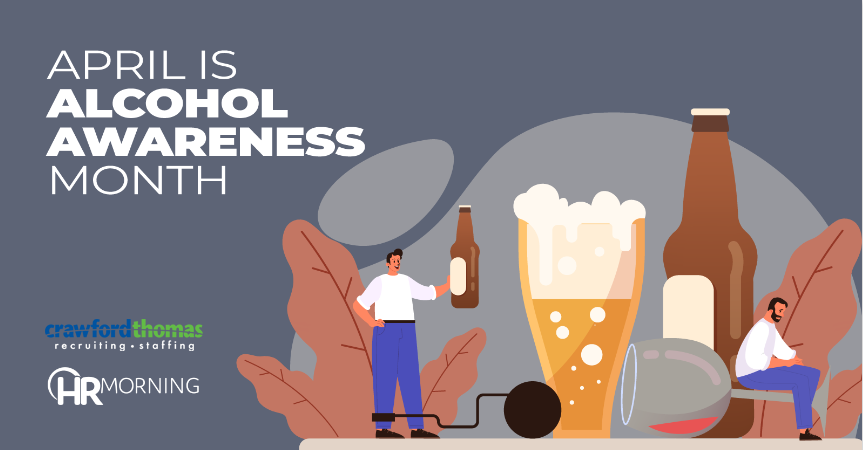April is Alcohol Awareness Month, aimed at increasing outreach and education surrounding the dangers of alcoholism and other alcohol-related issues.
Original article here.
These issues are especially tough to talk about in the workplace, but alcoholism and other substance use disorders aren’t just personal issues. Alcoholism is a disease that can permeate every part of a person’s life, including at work.
An employee struggling with alcoholism can cause real, impactful ripple effects throughout an organization. In fact, workplace alcoholism and alcohol abuse amount to lost productivity, healthcare costs, traffic accidents and personal tragedies totaling between $33 billion to $68 billion per year, per OPM.
Alcoholism is a workplace issue that HR needs to stay aware of and on top of, even when it may seem out of their realm of responsibility.
Alcoholism in the workplace
Throughout the years, many companies have gotten increasingly lax about alcohol in the workplace. From start-ups offering in-office bars to virtual happy hours during the pandemic, many companies use alcohol and social drinking as a team-building tool.
This drinking culture could lead employees – even if not all-out alcoholics – to do some undesirable behaviors. “Even if alcohol abuse is not an ongoing issue, it is very common for people to overindulge at a company party, event or happy hour, and career consequences from one bad moment can be life-changing,” advises William Stonehouse III, president and co-founder of Crawford Thomas Recruiting.
The effects go far beyond an embarrassing or inappropriate moment at a company event. Employee alcohol abuse can lead to:
- Health problems: Long-term alcohol abuse can lead to a wide range of health problems which may lead to increased sick time.
- Safety concerns: Alcohol abuse can impair an employee’s judgment and motor skills, increasing the risk of accidents and injuries in the workplace. “DUIs are another concern from a cost perspective as they can make some employees uninsurable or extremely more expensive to insure for positions that require driving,” says Stonehouse.
- Strained relationships: Alcohol abuse may lead to strained relationships with co-workers, friends and family members.
- Financial consequences: Alcohol abuse can lead to financial consequences such as missed workdays, reduced earning potential and increased healthcare costs. “When people think about the cost, they only think of intoxicated employees at work but the true cost can extend to being hungover at work, calling out sick and disruptive behavior at company functions where alcohol is served,” says Stonehouse.
The issue of alcoholism and alcohol at work pops up in all models of work, including hybrid and remote.
“In the early days of the pandemic and the transition to work from home drinking during the workday may have been an increased challenge, and it does seem to be a concern for some employers,” says Stonehouse. “Since the [remote] or hybrid employees are remote, it’s harder to tell than those [who] are in office full time. The emphasis and benchmark has to be productivity metrics to gauge effectiveness and to help detect decreased engagement.”
Workplace warning signs and next steps
Addressing these issues in the workplace can seem daunting. Falsely accusing an employee can lead to major trouble, so it’s important to balance the delicacy of the situation with prioritizing the health and safety of all employees.
According to Stonehouse, common warning signs of alcohol abuse from employees include:
- Frequent absences or tardiness: Employees who are struggling with alcohol abuse may frequently miss work or show up late.
- Poor job performance: Employees who are struggling with alcohol abuse may have decreased productivity, make mistakes and have difficulty concentrating.
- Changes in behavior: Employees who are struggling with alcohol abuse may exhibit mood swings, become irritable or defensive and have difficulty controlling their emotions.
- Physical signs: Employees who are struggling with alcohol abuse may have slurred speech, bloodshot eyes and an unsteady gait.
Noticing these warning signs is one thing, but many employers struggle with where to go from there. “Coming from a place of empathy and care is more productive than a disciplinary type meeting,” says Stonehouse. It’s important to approach the situation carefully and with compassion instead of accusations.
Depending on the situation and its severity, you’ll want to refer the affected employee to resources to find help and support, such as:
- Employee assistance programs (EAPs): If your company offers an EAP, you may want to refer the employee to counseling to get additional support.
- Referral to a healthcare provider: If the situation is more severe, the best thing HR can do is refer the employee out to a trained professional. Employers can encourage employees to seek help from a healthcare provider, such as a primary care physician or a mental health professional.
- Referral to a support group: Local support groups such as Alcoholics Anonymous or SMART Recovery can help employees find a like-minded community to get peer support.
Crawford Thomas Recruiting:

Crawford Thomas is a team of leading HR recruiters. We not only fill staffing needs, we partner with organizations to find out how their recruiting needs tie into their business objectives. Through this, we are able to meet your staffing needs in a way that achieves organizational success.
Start securing top talent by visiting our page for employers today.

